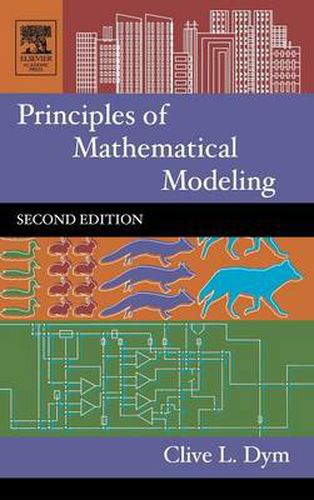Readings Newsletter
Become a Readings Member to make your shopping experience even easier.
Sign in or sign up for free!
You’re not far away from qualifying for FREE standard shipping within Australia
You’ve qualified for FREE standard shipping within Australia
The cart is loading…






Preface Acknowledgments Part A: Foundations 1. What is Mathematical Modeling? 2. Dimensional Analysis 3. Scale 4.Approximating and Validat ing Models Part B: Applications 5. Exponential Growth and Decay 6. Traffic Flow Models 7. Mo deling Free Vibration 8. Applying Vibration Models
9. Optimization: What is the Best…? Index Offers more than 360 problems, providing ample opportunities for practice Covers a wide range of interdisciplinary topics–from engineering to economics to the sciences Uses straightforward language and explanations that make modeling easy to understand and apply New to this Edition: A more systematic approach to mathematical modeling, outlining ten specific principles Expanded and reorganized chapters that flow in an increasing level of complexity Several new problems and updated applications Expanded figure captions that provide more information Improved accessibility and flexibility for teaching Science and engineering students depend heavily on concepts of mathematical modeling. In an age where almost everything is done on a computer, author Clive Dym believes that students need to understand and ‘own’ the underlying mathematics that computers are doing on their behalf. His goal for Principles of Mathematical Modeling, Second Edition, is to engage the student reader in developing a foundational understanding of the subject that will serve them well into their careers. The first half of the book begins with a clearly defined set of modeling principles, and then introduces a set of foundational tools including dimensional analysis, scaling techniques, and approximation and validation techniques. The second half demonstrates the latest applications for these tools to a broad variety of subjects, including exponential growth and decay in fields ranging from biology to economics, traffic flow, free and forced vibration of mechanical and other systems, and optimization problems in biology, structures, and social decision making. Prospective students should have already completed courses in elementary algebra, trigonometry, and first-year calculus and have some familiarity with differential equations and basic physics.
$9.00 standard shipping within Australia
FREE standard shipping within Australia for orders over $100.00
Express & International shipping calculated at checkout
Stock availability can be subject to change without notice. We recommend calling the shop or contacting our online team to check availability of low stock items. Please see our Shopping Online page for more details.
Preface Acknowledgments Part A: Foundations 1. What is Mathematical Modeling? 2. Dimensional Analysis 3. Scale 4.Approximating and Validat ing Models Part B: Applications 5. Exponential Growth and Decay 6. Traffic Flow Models 7. Mo deling Free Vibration 8. Applying Vibration Models
9. Optimization: What is the Best…? Index Offers more than 360 problems, providing ample opportunities for practice Covers a wide range of interdisciplinary topics–from engineering to economics to the sciences Uses straightforward language and explanations that make modeling easy to understand and apply New to this Edition: A more systematic approach to mathematical modeling, outlining ten specific principles Expanded and reorganized chapters that flow in an increasing level of complexity Several new problems and updated applications Expanded figure captions that provide more information Improved accessibility and flexibility for teaching Science and engineering students depend heavily on concepts of mathematical modeling. In an age where almost everything is done on a computer, author Clive Dym believes that students need to understand and ‘own’ the underlying mathematics that computers are doing on their behalf. His goal for Principles of Mathematical Modeling, Second Edition, is to engage the student reader in developing a foundational understanding of the subject that will serve them well into their careers. The first half of the book begins with a clearly defined set of modeling principles, and then introduces a set of foundational tools including dimensional analysis, scaling techniques, and approximation and validation techniques. The second half demonstrates the latest applications for these tools to a broad variety of subjects, including exponential growth and decay in fields ranging from biology to economics, traffic flow, free and forced vibration of mechanical and other systems, and optimization problems in biology, structures, and social decision making. Prospective students should have already completed courses in elementary algebra, trigonometry, and first-year calculus and have some familiarity with differential equations and basic physics.